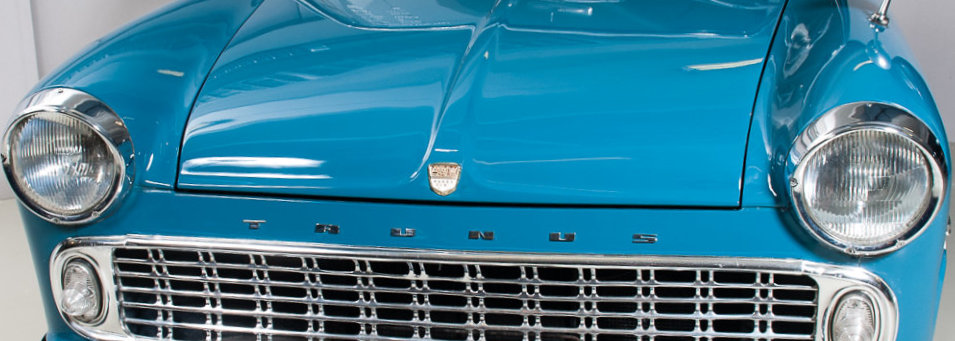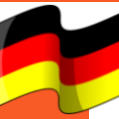



A German made Ford - Weltkugeltaunus

Ford Taunus 12M -61
The
Ford
Taunus
12
M
is
a
small
family
saloon/sedan
produced
by
Ford
of
Germany
from
1952.
Between
1955
and
1959
it
was
joined
by
the
larger-engined
Ford
Taunus
15M.
The company produced a succession of Ford Taunus 12M models until 1970, because the name was applied to a succession of similarly sized cars, but the first Ford Taunus 12M models, based on the company’s Taunus Project 1 (P1), remained in production only until 1962: in 1962 the Taunus P1 series was replaced by the Taunus P4 series. At its launch, the car placed Ford ahead of the pack, being unusually modern in terms of the bits that showed. It was one of the first new cars to appear in Germany since before the war, and featured a radical ponton format “three box” body as pioneered (at least in Germany) by the 1949 Borgward. The three-box car body format would soon become mainstream, but when the Ford Taunus 12M appeared in 1952 competitor manufacturers including Opel, Volkswagen and Auto Union were still competing with models based closely on designs originating in the 1930sGlobe Taunus / „Weltkugeltaunus“ (1952–1959)
Development
Planning for Ford Germany’s new ponton bodied passenger car began in 1949. Several aspects of the car’s development reflected the advantages and the disadvantages of running a business with management decisions necessarily split between two continents at a time when even international telephone calls needed to be pre-booked. The original plan for the strikingly modern design came from Ford in the USA who drew up a proposal based on the ponton format Champion model introduced to the US auto-market a few years earlier by Studebaker. The Studebaker design had already proved highly influential on the domestic programs of mainstream US auto-makers. Cologne based production engineers adapted the US proposal for the German market. The Studebaker featured a large roundel directly above the front grill on which was displayed the propeller of an airplane. The Ford Project 1 also featured a prominent roundel at the front of the car, but in place of the Studebaker’s propeller design, the Ford roundel featured a hemispherical depiction of half a globe. This bold and unusual decoration led to the new car becoming known as the „Weltkugeltaunus“ (Globe Taunus). The proposal from Ford in America called for a monocoque construction, following the lead (in Germany) of the 1937 Opel Olympia. Ford of Germany had no experience of this construction method, having spent most of the 1940s concentrating on building light trucks. Project 1’s predecessor, the Ford Taunus designed in the 1930s, had had its body built by an independent specialist pressed steel body builder in Berlin until 1948, and after the Berlin firm had its surviving plant crated up and shipped to the Soviet Union, Ford had in 1948 been driven to having Ford Taunus bodies produced by competitors and specialists from northern Germany, Volkswagen and Karmann. Ford’s Cologne management sought cooperation from other German auto-makers with developing the processes necessary for producing the monocoque Project 1 model, but the other German auto-makers had priorities of their own, and in the end it was with support from Ford of France that the production lines for German Ford’s project 1 were set up at the company’s Cologne plant. In due course, and not before a certain amount of confusion concerning the naming of the car, Ford’s Project 1 was released to the market as the Ford Taunus 12M. It proved a success. By the time the half globe was removed from the car’s nose, 247,174 of the 12M version had been sold along with 127,942 of the subsequently introduced Ford Taunus 15Ms.The name
The naming of the car is another area which may have been complicated by the way that responsibilities were shared between different management teams in two continents divided by an eight-hour time difference and the Atlantic Ocean. The immediate postwar era was seen as a new beginning for a newly divided Germany with, in the west, new borders, a new constitution and a new political class. The monocoque bodied new model for 1952 also represented a new beginning for Ford, so identifying it as Ford of Germany’s Project 1 (P1) was evidently uncontentious. In the 1930s Ford of Germany had, along with Opel, pioneered the use of model names that would have positive associations for customers. While Auto Union customers were enticed to buy cars with names such as DKW F8 and BMW were inviting customers to be seduced by names such as BMW 326, Ford were selling the Ford Köln, named after a major cathedral city as well as the Ford Eifel and the Ford Taunus named after hilly areas of great natural beauty. For Project 1, Ford Germany evidently intended to invoke another hilly region of natural beauty, and the name “Ford Hunsrück” was thought uncontroversial for a successor to the Ford Taunus. However, the “Hunsrück” name was blocked shortly before launch, possibly because of problems encountered explaining the pronunciation of “Hunsrück” to management colleagues in Dearborn. This left the name Taunus, and it was proposed to name the new car “Taunus 12 Meisterstück" in order to differentiate it from the existing Ford Taunus which was by now an aging model that would nevertheless continue to be listed in parallel with the new model throughout most of 1952. However, it transpired that the name “Meisterstück” ("Masterpiece") was unavailable for any Ford vehicle, having been patent-protected by a German bicycle manufacturer. Therefore by the time Ford’s radical new car came to market it arrived under the name “Ford Taunus 12M”. The “12” in the name referred to the engine size of 1.2 litres and the “M” was the only part of the “Meisterstück” name available to Ford.The engines
During development it was intended that the car would be powered by a 1,498 cc engine. This was in many respects the engine that had originally been intended for the previous Ford Taunus first produced in 1939, but now it was to be developed into an ohv unit. However, cost constraints intervened, and when the new Taunus 12M appeared in 1952 it was powered by the 1,172 cc side-valve unit that had powered not merely its predecessor, but also its predecessor’s predecessor, the Ford Eifel of 1935. By 1952 sidevalve engines were already seen as old fashioned. In an analysis undertaken of the models shown at the 1952 Paris Motor Show it was noted that 48 of the cars exhibited were fitted with engines employing overhead valves while only 6 featured sidevalve engines. That Ford were still powering their entry level Taunus P1 with a sidevalve engine ten years later, in 1962, would leave the model looking badly outclassed under the bonnet/hood.The body and running gear
The two-door modern slab sided Ford Taunus that appeared in January 1952 with an old fashioned engine married to a stylish new body was connected with the road using fashionably small 13“ wheels which will have saved on cost and maximised the space available for passengers and their luggage. Individually suspended front wheels marked a contrast with the approach taken with the original Taunus, but in 1952 the rigid rear axle was all too familiar to Ford’s existing German customers. The old Taunus had acquired the option of a four-speed gear box in 1950, but the new model at its 1952 launch came only with the older three-speed box, controlled using a column-mounted lever. (Until the 1960s European cars in this class never offered the option of an automatic gear change.) In the early years all the cars, regardless of equipment level, and whether saloon/sedan, or cabriolet bodied, came with a single bench seat across the full width of the car in place of the individual front seats fitted by most European manufacturers: this was a matter in respect of which the Taunus 12M was seen to reflect it’s manufacturer’s North American parentage and thereby conferred a certain glamour at a time when the USA was a widely accepted role model across much of Europe and especially in West Germany. A maximum 38 PS/hp (28 kW) of power was delivered to the rear wheels. This was a useful increase on the 34 PS (25 kW; 34 hp) claimed for the previous model, and may have reflected a higher compression ratio and increases starting to come through across Europe in respect of available fuel octane levels. In May 1953 the Taunus P1 finally became available with a four-speed gear box, though only as an optional extra. It was also at this point that a 3-door kombi/estate version joined the range. A cabriolet version had been offered since December 1952, being the result of a conversion by a coach building specialist based, like Ford, in the Cologne area and called Karl DeutschBroadening the range
Poor workmanship on the early cars was a source of some disappointment. Nevertheless, fairly soon (and in the absence of much direct competition during its early years on the German market) the Ford Taunus 12M, with its roomy modern body came to be seen as a high quality product, but on launch it was 37% more expensive than the 1952 price of the predecessor model. By this time another 1200 cc small car, the Volkswagen Beetle, was also gaining a foothold in the market place, and while the Volkswagen could not compete with the new Taunus 12M on cabin space, its lower price offered a compelling argument in a country still impoverished after the traumas of war and national defeat. By the end of 1952 the old Taunus had disappeared from the Ford showrooms, and in December 1952 management decided to offer a stripped down version of the new Taunus 12M, with all the chrome trimmings and various other "unnecessary" elements removed. In place of the US-style front bench seat the basic version had two individual front seats which comprised simple non-adjustable steel frames with a thin coating of plastic fabric. In place of the US-style column-mounted gear change the stripped down version featured a gear lever in the middle of the floor between the two front seats: this was considered very old fashioned at the time. The basic Ford Taunus 12 was offered only as a two-door saloon/sedan. The stripped down Taunus 12 nevertheless retailed at more than 10% less than the price of a Ford Taunus 12M. And for only forty marks extra, the buyer of the basic car could upgrade his gear-change mechanism to the coveted column-mounted device.Facelifts and upgrades
In 1955 the Taunus 12M received its first facelift. The formerly split chrome grill was replaced by a simplified single piece grill. The prominent hemi-spherical globe design above the grill at this time remained in position, however. By now the base price for the Ford Taunus 12M had been reduced to below 6,000 Marks, and with incomes on the rise nationally the stripped down Ford Taunus 12 was quietly dropped from the range. From 1957 the Taunus 12M joined other German automakers in offering the automatic “Saxomat” clutch as an option In 1958 the wide chrome bars of the radiator grill were replaced by a less flamboyant grill. But the globe design directly above the grill lasted another year.
1961
Engine 1172 cc 4 cylinders Power 38 HP Top speed 125 km/ Lenght/width 4,06 m/1,57 m

Photos mainly by Matti Kreivilä. Historical facts and technical details of the vehicles provided by Wikipedia. Movies YouTube.



- Decade of 60's
- Austin 850 Pickup - 1962
- Chaika Tshaika 13 GAZ - 1962
- Citroen 2CV - 1961
- DKW Junior - 1961
- Fiat 1100 - 1963
- Ford Taunus 12M - 1961
- GLAS 1204 - 1963
- MG 1100 - 1964
- Moskvich 407 - 1961
- Nagetusch caravan - 1961
- NSU Printz 4 - 1961
- Opel Kadett A - 1964
- Panhard PL17 - 1961
- Peugeot 404 - 1962
- Renault Dauphine - 1965
- Simca Aronde P60 - 1960
- Simca 1000 - 1966















